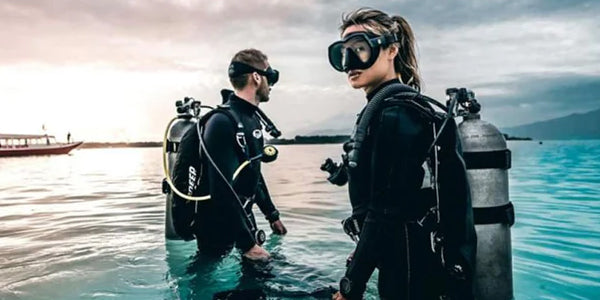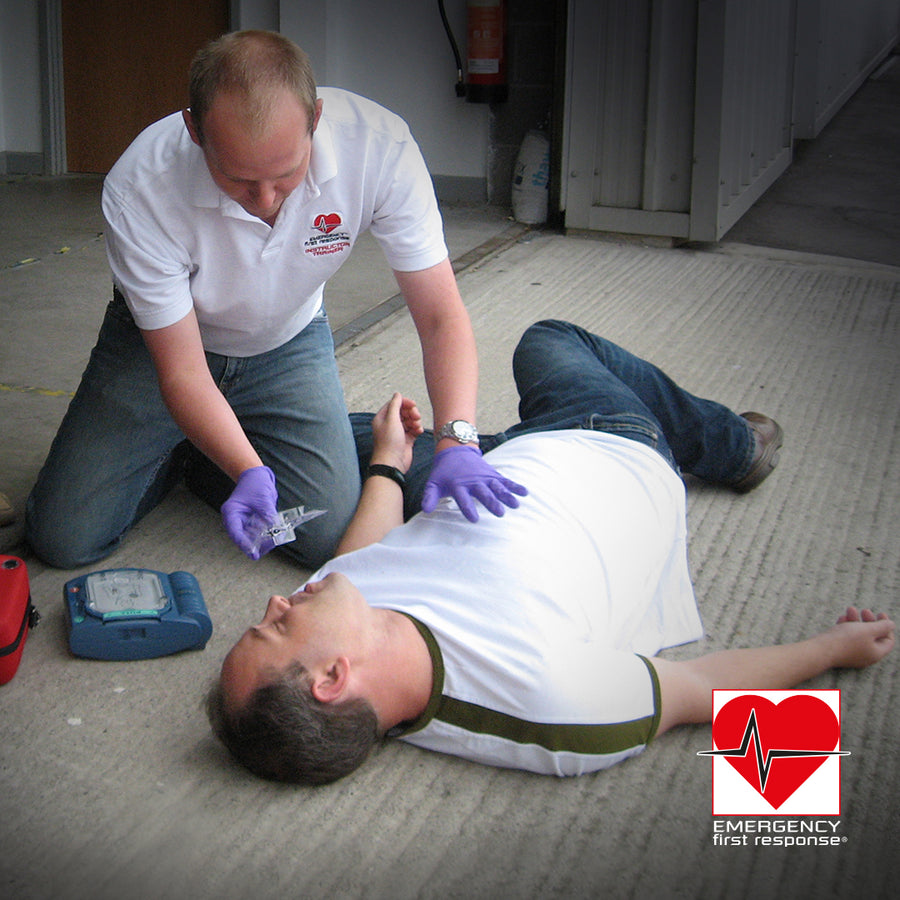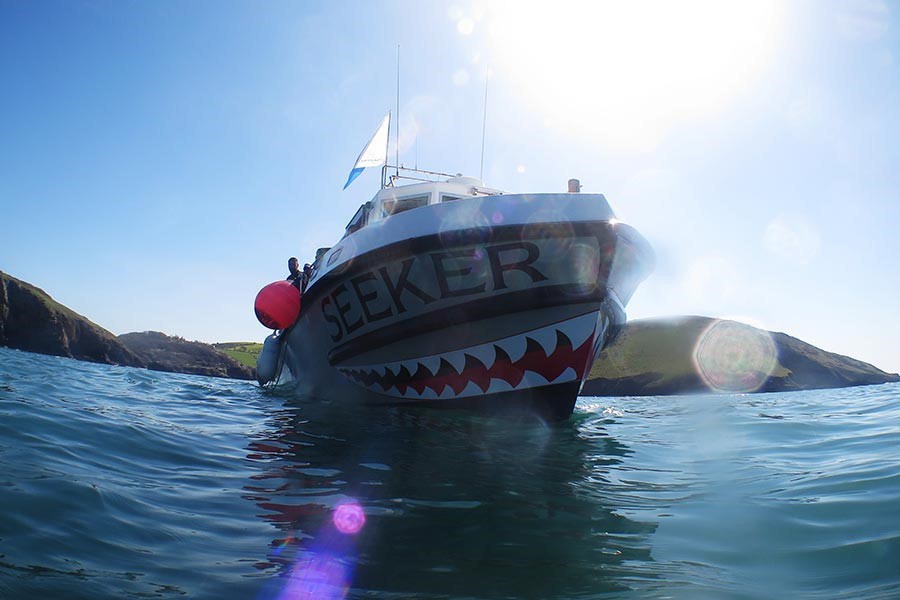Staying Warm Whilst Diving

STAYING WARM WHILST DIVING IS IMPORTANT, PARTICULARLY DURING THE UK WINTER MONTHS. DIVING IN WINTER OFFERS BETTER VISIBILITY, PARTICULARLY IN OUR INLAND QUARRIES, AND CAN EXTEND YOUR SEASON.

What is the definition of Cold Water Diving?
Let us start with saying the EU norm considers cold water diving to be when the temperature of the water is equal to or drops below 6 degrees.
The sea around the UK is rarely colder than about 8°C, so that leaves the inland freshwater sites where we dive, such as Stoney Cove, where the significantly lower temperatures can be encountered (it got to 5 degrees in February 2018). So, learning the "stay warm" tricks to allow you to dive all year round is important and remember this is when some of the best visibility occurs in those inland sites.
Classifying Cold
There are three primary factors that affects your tolerance to cold:-
- Physiological - a person’s body shape, size and circulation.
- Equipment - how effectively the body is insulated.
- Psychological - one’s perceptions and expectations.
All three factors are separate drivers that are assessed and addressed differently, yet all three are inextricably linked.
There is no specific point at which warm water becomes cold water or when cold water becomes extreme cold water, as any such distinctions are dependent primarily upon one’s body, experience, equipment and attitude. Temperatures from 20°C down to 7°C would be the average range that most cold water divers would dive with wetsuits at the top of the spectrum and usually in drysuit's towards the bottom of the range.
Below 7°C down to 4°C is when most find the water very cold, even with a drysuit, divers may emerge chilled.
Technical divers with extended decompression requirements may spend hours submerged in cold water and as the length of exposure increases, so does the need to take special measures.
Hypothermia
As a Diver you should be aware of what Hypothermia is and how to recognise it. This is something that is covered on the EFR Primary and Secondary course and we have an separate blog on hypothermia
As body heat is lost, the body approaches hypothermia however; recognising hypothermia in its early stages in diving can be difficult. Severe hypothermia, defined as a rectal temperature of 35° C or lower, is dangerous; and at this stage, a diver may become helpless.
Chilling, even if not severe enough to threaten life, will produce loss of dexterity and sense of touch in the hands, making it difficult for a diver to do useful work or even to control diving equipment such as weight belts and buoyancy compensators. Shivering causes a lack of coordination and may make it difficult for a diver to hold the mouthpiece in place. By the time shivering becomes uncontrollable, oxygen consumption will have increased significantly and consequently the dive should be terminated and rewarming started before the diver reaches this point.
The ability to think clearly and short-term memory may also be affected seriously by cold. When diving in cold water, it is essential for the diver to:
- Wear thermal protection appropriate for the water temperature
- Note the first signs of cold hands and feet and loss of dexterity and grip strength
- Note difficulty in performing routine tasks, confusion, or a tendency to repeat tasks or procedures
- Note feelings of being chilled followed by intermittent shivering, even though routine tasks can still be performed
- Terminate a dive if any of the above symptoms are present
- Be aware that even when properly dressed, hypothermia may develop without shivering
- Watch the buddy diver and take heed of any behavioural changes that may indicate existing or approaching hypothermia.
Diving in cold conditions also requires special emergency equipment to treat hypothermia and, as importantly, knowledge of cold weather afflictions to identify them in the early stages, take the EFR Primary and Secondary course and keep your skills current.
Surface Considerations
Equipment
The equipment used on the surface may be as important to divers’ comfort. A heated environment to gear up and afterwards undress in can make an enormous difference not only to divers’ comfort and morale but also to keep equipment from freezing if surface temperatures are below freezing.
Large windproof coveralls (DryRobe, Moonwrap or Fourth Element STORM Poncho) may be worn over a fully dressed drysuit diver on the way to a dive site or in between dives.
Drink
Up to 60% of your body is made up of water and water helps regulate your body temperature.
If you aren’t adequately hydrated, your body becomes more sensitive to temperature fluctuations.
Eat
Another factor to consider is that consuming calories also serves to warm the body up, as essentially you are contributing energy to your system. Because cold weather makes your body temperature drop, therefore eating before and after diving are also critical to keeping energy levels high. Eating makes us warmer.
Underwater
Staying Warm
Obviously, a diver exposed to cold water or even moderately warm water for long periods, must wear protective clothing. Because of large individual differences in cold tolerance, every diver must determine the most suitable protection on an individual basis. A variety of diving suits are available, ranging from standard foamed neoprene wet suits and drysuit's to specially heated suits.
The use of protective equipment, however, creates a complication because the body's defence mechanism is modified by the thermal barrier of the clothing. This complication is only just being recognised as important, and divers should be aware that the faster the rate of heat loss, the smaller the drop in core temperature for a given quantity of heat loss. Furthermore, whether or not a person shivers is strongly influenced by:
- The rate of body heat loss
- The amount of body fat
- The body size. larger, fatter people are less affected by a given cold exposure and less affected by a given amount of heat loss. For example, because heat transfer is about 100 to 200 times faster in water than in air, the heat that reaches the skin surface is rapidly transferred to the water. Generally, the thicker the layer of subcutaneous fat, the greater the insulation.
During swimming, the increase in energy production resulting from exercise is counterbalanced by the increase in muscle blood flow resulting in greater heat transfer. Thus swimming promotes faster transfer of heat from the core to the periphery, and this heat is in turn lost to the water. This is why persons suddenly immersed in cold water or divers becoming cold are better off remaining still than trying to swim.
Rapid heat loss provokes strong shivering, so that the diver is warmed. Gradual heat loss over a long time often will not cause shivering, yet the accumulated cooling and the likelihood of hypothermia may be even greater, with the likely result of impaired performance.
Baselayers
A critical factor in warmth is the clothing worn beneath the drysuit. Dry suits provide different degrees of insulation and so the optimal number of layers to maximise warmth while maintaining flexibility can be perfected over time.
- Base Layer - The first layer will remove moisture from the body and should be a lightweight synthetic or silk long underwear. Moisture may enter as perspiration while gearing up, from exertion during the dive or from any trickle of water that may come through the drysuit. Avoid cotton and wool, which do a poor job of transporting heat and moisture, and once wet, tend to stay wet resulting in a large loss of body heat. This wicking layer should fit fairly snugly against your skin, without being restrictive.
- Primary Insulating Layers - The insulating layer is worn over the base layer and traps body heat while allowing perspiration to escape. This may consist of one or more layers and is typically mid weight fleece. Cheap discount brands of fleece will compress and pill and lose their insulating value and it is recommended to use named brand manufacturers such as Fourth Element, Santi or Apeks. Feet should also have an insulating layer using either fleece or wool socks again Fourth Elements Hotfoot Pro or Arctic socks are recommended
- Under Suit - Both the wicking layer and insulating layer(s) provide additional insulation underneath a under suit such as those made by Fourth Element, Santi and most drysuit manufacturers. Adding additional layers beneath the under suit is one of the critical differences between diving in cold water and diving in extreme cold.
Have a look at our Base layer options here
Fourth Element
Take a look at the Fourth Element Guide to layering
However there is no universal 'rule' for what baselayer should be used in what conditions.
Gloves
Dry gloves are warmer, but can be somewhat blubbery when on the surface. They also suffer from squeeze as you descend, but this can be mitigated with a nice Merino Wool Liner (the Fourth Element AR Gloves are particularly warm). Many divers prefer the perceived simplicity of standard wet gloves, but they get more tempting the older I get!
Regardless of how warm your body may be, if your hands get very cold, the end result is significant discomfort and possible danger as your dexterity disappears with the cold. Your hands are a vital piece of equipment and it is simply not worth skimping on insulating them properly in cold water.
Have a dry suit with neoprene seals? It use to be that you would require dry gloves with latex seals to seal under the neoprene seal but Northern Diver now do a system you can glue to your suit.
Hoods
In cold water, a hood is essential since 80% of body heat escapes through the head. Neoprene hoods come in different thicknesses, typically 3, 5 and 7mm, the thicker the warmer, however, any thicker and they can become uncomfortable. It is important to get a good snug fit to minimise any water flow and also it should cover as much of the head as possible without compromising masks and regulators.
Looking for Hoods and Gloves then have a look here
Drysuit
The most important consideration with a drysuit is to ensure that it fits properly. Fit is critical for both warmth and dexterity. The height, shoe size, wrist and neck seals must all be exact to eliminate any water trickling in and for the best insulation.
Telescoping drysuit's allow people of different heights to use the same suit but using a larger shoe size or too tight a neck seal is undesirable.
The drysuit should be maintained and every couple of years, depending upon use, may need seals or the zip replaced as they wear down. There is no one particular type of drysuit that is best for extreme cold water diving.
Many factors including cost, fit, strength of material if diving around areas with high abrasion, ease of repair and any potential contaminants will all affect the ideal choice. Any properly fitting drysuit with appropriate undergarments should keep a diver warm.
Based purely on warmth, a neoprene suit would be the warmest but neoprene suits compress with depth and tend to lose some of their insulating qualities while also requiring more weight and generally don’t permit as much clothing underneath. Crushed neoprene solves many of these problem but isn't as warm as neoprene, though it is warmer than trilaminate or vulcanised rubber suits. Both neoprene and crushed neoprene take the longest time to dry and if surface temperatures are below freezing will freeze hard whereas rubber or trilam can be dried with a towel.
Divers stay warm in all suits and in the end there is no one right or wrong choice, its all about the suit and base layers.
The preferred location for the inflator is on the chest with the exhaust valve on the arm above the elbow. Exhaust valves on the ankles are unnecessary and exhaust valves placed on the forearm make leaks through the wrist seal more likely as excess air accumulates in the wrist and the valve may also interfere with dive computers or wrist slates. An exhaust valve around the bicep permits the diver’s arm to bend when exhausting air, which stops excess air from accumulating at the wrist seal.
Options on a drysuit that are helpful include a rotating inflator valve, adjustable exhaust valve, self donning zipper, relief zipper or valve, internal suspenders and possibly some type of integrated boot if walking frequently on rocks or snow. An inflator whip with a large coupler will make it easier to attach and detach while wearing dry gloves.
Looking for a drysuit then here are a few options
Wetsuit
Here at Dive Rutland we do not advocate diving in a wetsuit during the winter months, if you are being asked to or choose to then you need a wetsuit that is a good fit and is a Farmer John Style suit and most importantly does NOT allow water to flush through. It should also be a reasonable thickness - 5mm or 7mm. If your instructor is in a drysuit then maybe you should be to!
Buoyancy Control Device (BCD)
There are no special cold water considerations for the BC other than to ensure that it fits properly over the additional insulation. BCDs selected for diving with minimal insulation in the tropics may not be ideally suited for the additional bulk the insulation will create.
Back mounted flotation bladders (wings) with an adjustable harness are preferable over fixed size BCDs with side inflation. It is important to remember to bring BCDs in from the cold as inflator and deflator valves may freeze shut and ice crystals can damage BC bladders.
Fins
Like the BCD, the most important thing is simply to ensure that they fit properly over the drysuit with all the insulation. Large quick release buckles will make it easier to don or remove the fins while wearing dry gloves and extra straps are even more important as they tend to be more brittle in cold weather, but a spring heel strap does make it easier to get fins on and off and well worth the investment.
Have a read of our article on Choosing Fins for more information
Weights
Cold water diving requires a significant amount of insulation and a diver will likely need a extra weight, especially if diving in salt water. It is not uncommon for a large diver to require as much as 20Kg (50Lbs). Correctly distributing this weight will make gearing up, entries and exits much easier and will affect the diver’s trim and buoyancy. The harness stops the slipping and rotating of traditional belts, eliminates the risk of the weight belt loosening and evenly distributes weight to alleviate lower back stress. If using a standard weight belt, a double buckle and/or depth-compensating buckle will reduce the chance of the belt slipping off as is more common with thicker suits which may compress at depth.
The harness approach also allows for easy addition or subtraction of weights as may be necessary with changes to the number and type of undergarments worn. Distributing weight and reducing the weight carried on the belt or harness is also essential to facilitate movement, reduce stress on the lower back and make proper buoyancy easier.
There are many different ways and products to distribute weight. BCDs with weight-integrated pockets are useful but tend to make an already heavy rig harder to handle topside. Using steel tanks versus aluminium is a quick way to reduce the lead that must be carried.
Regardless of exactly how you decide to reposition weights, the important thing is to spread them around and to do so in a way that you can fine tune the quantities for proper trim while keeping enough weight that can be ditched to make an emergency ascent, remember a Perfect Buoyancy course assists with weight distribution.
Heaters
Electric heaters worn under the drysuit are another specialised option such as Santi Heated Vests and Santi heated gloves for those of us that use Dry Gloves.
Much cheaper reusable or disposable chemical heat packs may be used for additional heat on core areas or extremities that otherwise get cold but with caution and always above at least one, if not two, layers of clothing as once under the suit it can not be removed or turned off and may burn the skin when put under pressure.
Also consider none battery options such as the Fourth Element X-Core Vests Mens and Ladies
Regulators
If diving in cold water then your regulator should be suitable for cold water diving. Be aware that regulators can 'free-flow', more on that here
General
At the end of the day equipment choices are a personal thing, so before purchasing equipment drop in and have a chat.
Re-warming yourself after a dive
At the end of a dive, a cold diver should be re-warmed. This can be accomplished by having the diver drink hot liquids such as soup or coffee and dry off in a warm place. It is NOT about jumping into a HOT shower and fast warming, why not? as a diver you are still releasing nitrogen ('Off gassing') and rapid warming means the body releases the nitrogen much quicker, in fact equate it to a fast ascent. Releasing Nitrogen fast can lead to Nitrogen Narcosis.
Warm up slowly, by wrapping yourself in a Dryrobe or Fourth Element Storm Poncho, then retreat to a warm room, get changed into dry clothes and retire to the pub!
Also ensure your diving skills are maintained by regularly practising in the pool, one of the benefits of being a Dive Rutland Club member
Last Updated: Dive Rutland v1.00 November 2016 / v2.0 February 2017 / v3.0 December 2018 / v4.0 December 2019/v5.0 January 2021/ v5.1 March 2022 / v5.2 Jan 2023 / v5.4 Nov 2024










